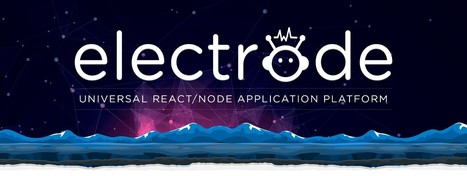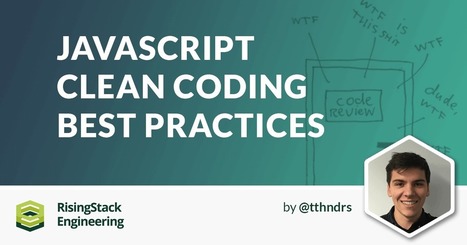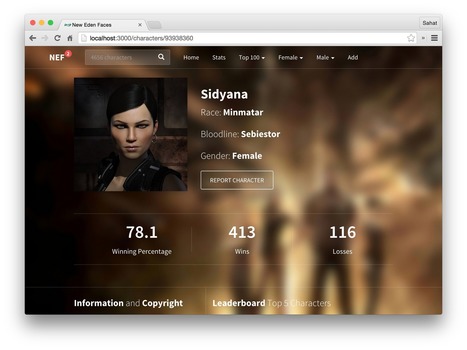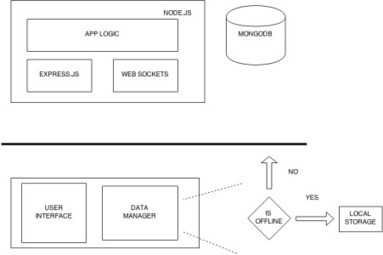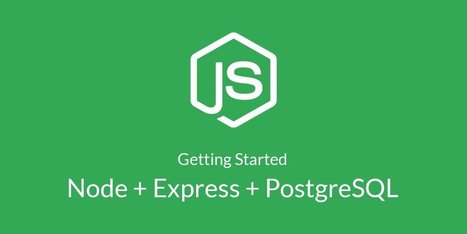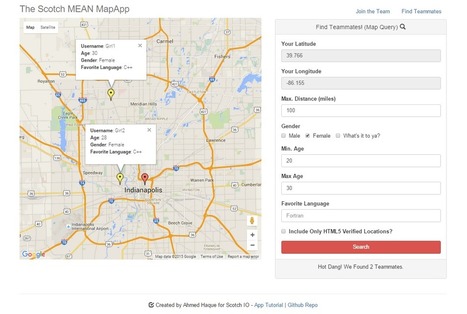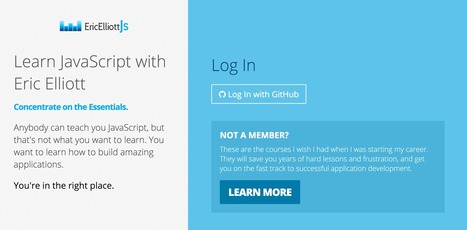80 million monthly visitors, loads up to 10,000 requests per second, and 15 million items, adding more than one million new items each month is what Walmart.com’s scale is all about. With an e-commerce business that holds the number two online retailer spot in the U.S., we needed not just to scale Walmart.com, but to really leverage the talent and creativity of our engineering base.
Get Started for FREE
Sign up with Facebook Sign up with X
I don't have a Facebook or a X account



 Your new post is loading... Your new post is loading...
 Your new post is loading... Your new post is loading...
Current selected tag: 'Node.js'. Clear
No comment yet.
Sign up to comment
This post covers general clean coding guidelines for naming and using variables & functions, as well as some JavaScript specific clean coding best practices
From
hashnode
This is a step-by-step tutorial that will help you get up to speed with React quickly, and also build a complete app with the MERN (Mongo-Express-React-Node) stack. You'll also learn other tools that you typically use to build an app: Gulp, Browserify, Material-UI and React-Bootstrap.
From
mern
MERN is a scaffolding tool which makes it easy to build isomorphic apps using Mongo, Express, React and NodeJS. It minimizes the setup time and gets you up to speed using proven technologies. In this tutorial we are going to build a character voting app (inspired by Facemash) for EVE Online - a massively multiplayer online game. You will learn how to build a REST API with Node.js, save and retrieve data from MongoDB, track online visitors in real-time using Socket.IO, build a single-page app experience using React + Flux with server-side rendering and then finally deploy it to the cloud. With the proliferation of more and more of the web being driven by JavaScript, The speed of the browser DOM is becoming increasingly noticeable. Lots of sites being driven by popular JavaScript frameworks like Ember, Backbone, or Angular can take a while to render into the DOM. This forces the user to wait for the app to bootstrap itself before they can start viewing & ‘using’ the app. In this post I’ll discuss how I built CoffeeRun as a Single-Page Application (SPA) using Node.js and Knockout.js. This was my first foray into the world of SPAs and Node, so it’s written as a guide to anyone else who is looking to dip their toes in for the first time. I’ll also cover deployment to Azure. So, I went back and asked why Firebase and why are you fitting Firebase in your application architecture? Here are 2 major answers
After giving the above reasons a good thought, I have come up with the below architecture that will “emulate” Firebase using Websockets and Local Storage inside a Node.js/MongoD. If this solution gets stable over a period of time, I may create a yeoman/slush generator to scaffold a Node.js/Express.js and a MongoDB app with real time data sync and offline storage capabilities. For this post, I will use a simple Todo app as an example. Node.js v.s. Play Framework lecture by Yevgeniy(Jim) Brikman at ScalaMatsuri on 9/6/2014 http://scalamatsuri.org/en/
From
scotch
Authentication is one of the big parts of every application. Security is always something that is changing and evolving. We’ll build a quick API using Node and Express and we’ll be using POSTman to test it. The main workflow of this is that we will:
Node devs tend to be minimalists, DIY’ers, Lego™ artists, if you will. We want a nice set of tools and pieces at our disposal that we can compose into whatever creation we imagine. If you’ve bought into Node’s small module paradigm, stuff like Ember, Angular, and even jQuery can feel a bit like excessively large Duplo™ blocks. To be clear, this doesn’t make them bad. I’m glad they exist. Clearly, they empower scores of developers to create some great things on the frontend. Of course we think Ampersand modules are a great match for building frontends for our Node applications. But for Ampersand we use the term “framework” very loosely. As demonstrated by how people are using it, it’s really is just a loosely coupled set of tools. In the end, the only constant in our field is change. We simply cannot, in good conscience, assert that any single toolset (even our own) is the only valid approach. It’s just not how we think development should work. Today I would like to share with you how I build Node.js applications with the hope that someone else will find it useful. This article is structured in a sequence of steps that I use in my workflow and will attempt to be as detailed as possible.
|
We're going to be using PostgreSQL and Sequelize as the ORM of choice to write a minimalistic Todo list application. By the end of this tutorial, we will have created an API for a todo list application that will enable us to create multiple todos, add list items to those todos, update the list items and delete them. By working through an application in which we implement functionality to add things, update and delete them from a database, this tutorial will serve as an introduction to writing more advanced CRUD applications. Some highlight technologies:
Writing an API client in JavaScript is a lot of work, you have to write one for Node.js and one for the browser. I found out a way to have both on the same codebase with the same API, all that with only changes to the build scripts. It’s called isomorphic code, and doing it with modern TypeScript isn’t easy, but it’s achievable. TypeScript brings lots of advantages to the JavaScript world with almost mandatory typings. But TypeScript code is transpiled, and to play well with other libraries that aren’t originally written in TypeScript needs manually written type definition and some hacks to play well with other external tools, like code coverage and test frameworks. Today, we’ll be taking our work a step further by adding a new control panel that allows us to filter users based on a variety of fields. The final product will allow us to query our map based on gender, age, favorite language, proximity, and whether a user’s location has been HTML5 verified. Additionally, this tutorial will give us an opportunity to introduce some of MongoDB’s geospatial query tools.
From
benzhang
In our fast-changing world, technology is rapidly taking giant leaps forward. For the people who are just beginning to take part in this new “gold rush” of web development, it is sometimes inevitable to feel a sense of desperation of not being able to keep up with the evolution. In this article, I will attempt to give a brief overview of one of the most-adored features of Facebook’s Reactframework—isomorphism(a.k.a. server side rendering).
From
marmelab
Webpack is really a great JavaScript bundler, allowing to turn messy and numerous JavaScript into a single minified and optimized script. Yet, we missed a good getting started tutorial. Here is one... I know, I know it is too early to be building end to end apps with Angular 2.0. A MEAN stack app would typically consist of a server layer built with Nodejs & Express – Express being the web framework. MongoDB for data persistence & Angular as the client side MVW framework. First, we are going to setup an express app, build the REST API to Create, Read, Update & Delete todos and then integrate it with the Angular app.
From
thinkster
The goal of this tutorial is to guide you through the creation of a Reddit/Hacker News clone using the MEAN stack. By completing this tutorial, you will gain a basic understanding of the MEAN stack including building a REST interface with Express.js on top of Node.js and using that interface to perform CRUD operations on a database via an AngularJS frontend.
From
github
Isomorphic means that it's designed to run a lot of the same code on both the client and the server. Typically that includes a lot of rendering and domain logic. (Not to be confused with isomorphisms from category theory / functional programming. That's a totally different thing.) There are many advantages to building apps this way, but the primary advantages are:
A simple tutorial for working with Ember Data, Node, Express and MongoDB to build an api. I have really been enjoying working with EmberJS lately, once you get over the learning curve and understand how things should relate, it becomes really fast and fun! Lets take a look at how we can use Ember Data with Node (or io.js),Express and MongoDB. For this example lets use the Ember CLI to start an Ember application fast! Modular compact standard library for JavaScript. Includes polyfills for ECMAScript 5, ECMAScript 6: symbols, collections, iterators, promises, ECMAScript 7 proposals; setImmediate, array generics. Some additional features such as dictionaries, extended partial application, console cap, date formatting. You can require only standardized features polyfills, use features without global namespace pollution or create a custom build. |

